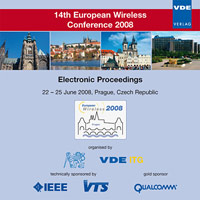QRD-M based Iterative Precoding for Multi-User Broadcast Channel
Konferenz: European Wireless 2008 - 14th European Wireless Conference
22.06.2008 - 25.06.2008 in Prague, Czech Republic
Tagungsband: European Wireless 2008
Seiten: 5Sprache: EnglischTyp: PDF
Persönliche VDE-Mitglieder erhalten auf diesen Artikel 10% Rabatt
Autoren:
Park, Kyungho; Kang, Joonhyuk (School of Engineering, Information and Communications University (ICU), 119, Munjiro, Yuseong-gu, Daejeon, 305-732, Korea)
Cha, Jongsub (RFID/USN Research Division, Electronics and Telecommunications Research Institute (ETRI), 138 Gajeongno Yuseong-gu Daejeon 305-700, Korea)
Inhalt:
In this paper, we propose a computationally efficient precoding algorithm based on an iterative QRD-M for multiuser MIMO broadcast system. It has been shown that the iterative QRD-M algorithm can achieve near-ML performance with lower complexity at MIMO detection. Using depth first tree-search strategy, the first full expansion is tried by selecting the first level node with a minimum metric, constituting a reference metric. To find best sequence, it iteratively visits each node and terminates the expansion by comparing node metrics with the calculated reference metric. However, the iterative QRDM algorithm applied in transmission side cannot significantly reduce the computational complexity, especially compared to sphere encoding. To further reduce the algorithm complexity, we introduce two additional techniques. One is to limit the search range according to the channel condition. In general, sequential algorithms show a variable amount of computation dependent on the channel condition. If the channel is ill-conditioned, we extend the search range. The other is to decide the reference metric that can be predetermined by the characteristic of VP and the first full expansion can also be pruned. By the pruning node during the first full expansion, the number of undesirable node visit can be further diminished. Simulation results show that the proposed algorithm can significantly reduce the computational loads with a slight performance degradation, compared to that of the sphere encoding.


